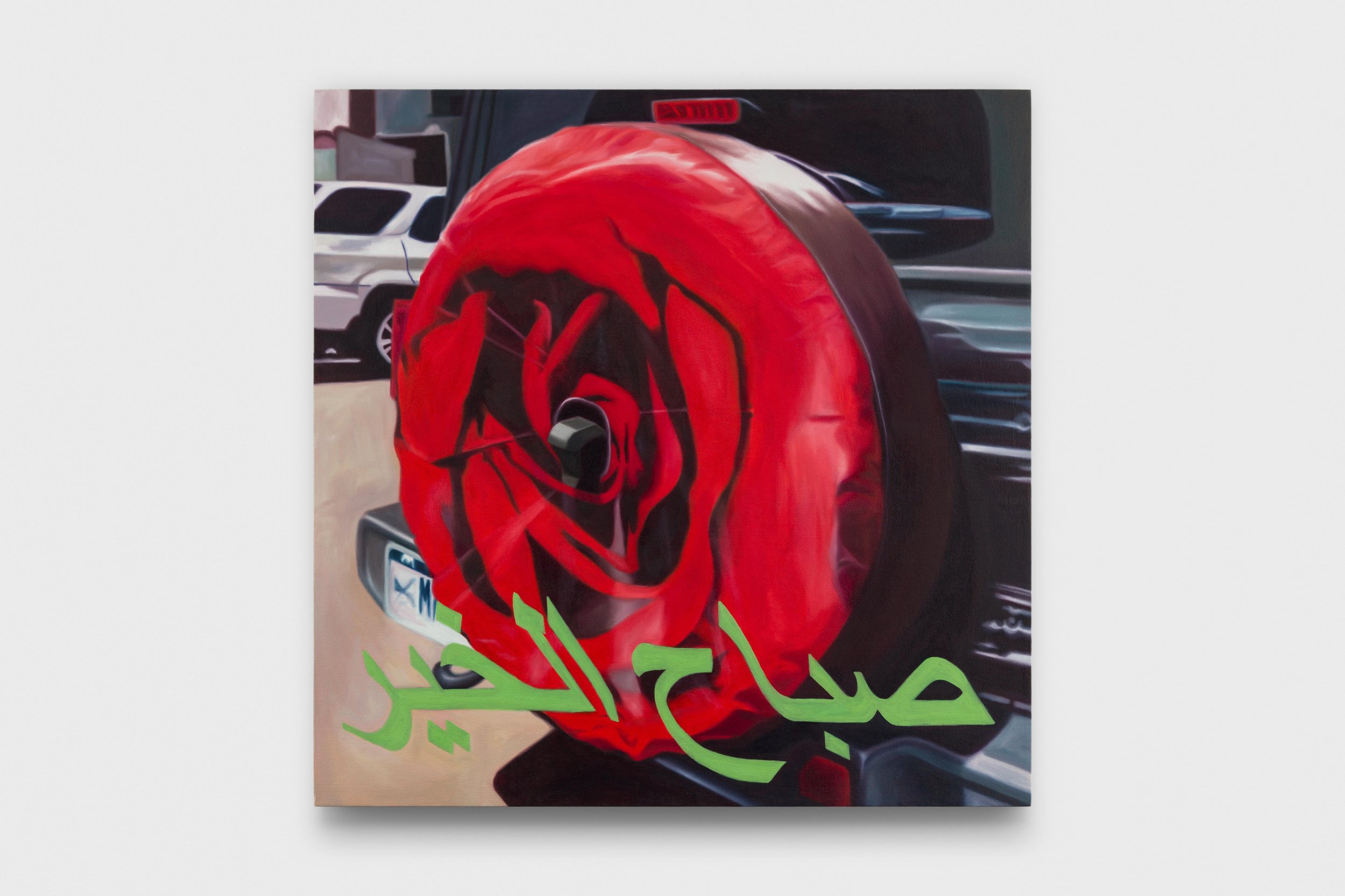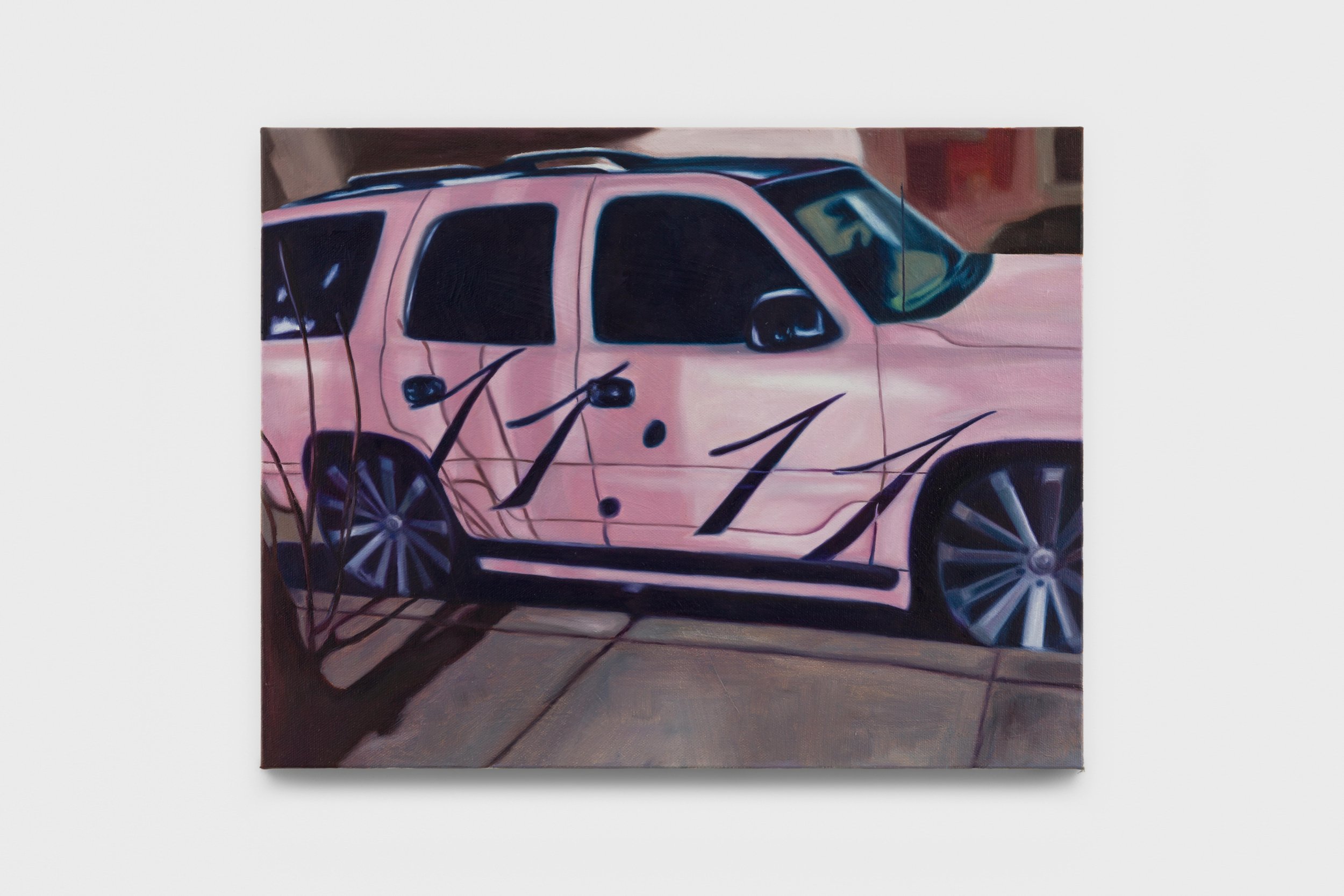Tasneem 'Neem' Sarkez on confronting the translational abstraction of Arabness
Photography by Sarah Sadia Daoui, 2023
Words by Sarah Sadia Daoui
At just 21 years old, Tasneem ‘Neem’ Sarkez has a piece acquired by the MET library’s permanent collection and a trio-show “Saccharine Symbols” held at Rose Easton Gallery in London. Her studio is a space not more than 80 sq. ft provided by the undergraduate studio art program at NYU Steinhardt, but vast in personal archival images and distinctively Arab mementos; a Palestinian can of beans holds her paintbrushes while early 2000s Nancy Ajram is just one of the many images gracing the walls. What initially drew me to Neem was her piece, Bad Tattoos, 2022, combining archival images of tattoos in Arabic text, it investigates the ironic virality of this niche bank of images, and reveals mistranslations, cultural taboos, and alternative Arab culture.
Born and raised in Portland, Oregon, Neem’s parents immigrated to the US from Libya in the 70s. Being of the Arab diaspora in New York City, confidants who understand the discomforting curiosity to embrace one's culture and heritage, while not corporeally living or knowing the experience of one's identity in its modern form, come far and few between. As a born and raised NY-er to Algerian parents, Neem’s work soothes this life-long yearning for me. Her interplay between traditional and modern representations of Arab-ness are eloquent, yet nonchalant and undisrupted. She fills the void between the generation of our parents, who were largely concerned with anti-colonial works, and millennial Arab artists who were only beginning to grapple with the power of the internet and social media vis à vis the Arab Spring. Neem has just arrived back from the exhibition opening in London, when I get to visit her studio, and hear her speak on the rhythmic like melody of painting a rose, and 1970s root derivative of the word “meme.”
Photography by Sarah Sadia Daoui, 2023
I’m curious about your attraction to Arabic calligraphy and text. I especially love the piece you have at Rose Easton right now, with the text over the rose on the back of the Jeep tire reading: “Good Morning.” Did you grow up learning how to read, write, and speak Arabic?
I did, my public school in Portland had an Arabic language program from middle school through high school. But I’ve only gotten into the use of Arabic text within my art more recently. It’s interesting you bring that up because a friend who visited my show “Beginner’s Luck” in New York was talking to me about how the embrace of Arab aesthetics, particularly through the use of Arabic calligraphy, doesn’t grant you safety, as in me - the artist.
Do you seek safety through your work as an artist? When I look at your work, it’s not something that I sense you particularly care about.
No. Yeah, I don’t. But it was interesting for her to express that directly to me, because it was not something I had considered before. As my work is getting more into the public eye, that’s something I do have to think about.
Do you feel like text on pieces in general, even with the English language, can make them less valuable?
No. I think it's only when it’s a language that’s not English, or does not use English letters in its character form that are at risk of that kind of negation. I’m not responsible for how people interpret Arabic. I don’t think I’m leading anyone in the direction to presume Arabic from hostile, or dangerous grounds. With Good Morning, 2023, it’s actually quite a romantic piece with the red rose, and scripted text that reads: Good Morning. I can guide so much in the painting. But its interpretation is ultimately out of my control.
Why roses?
It’s like painting what a melody sounds like, that’s what it feels like to paint a rose. It’s just so rhythmic and harmonious. They show up so much in Arab iconography and Arabic semiotics of different products. Even when you go to a Middle Eastern restaurant, they’ll make roses out of the tomatoes. I found this book, GOOD MORNING by Nathan Ross Davis and Sarah Elawad, on Saint Marks, and every page is a different Good Morning meme. You almost assume a flower, or a rose to always be there. I feel like it’s because roses are so powerful and significant in their symbol, not only for what they do for nature, but also for what it means to give someone a rose and what it means to send it, it’s this loving gesture.
Tasneem Sarkez Good Morning, 2023 oil on canvas - courtesy of the artist and Rose Easton, London. Photography by Jack Elliot Edwards
I noticed how Good Morning, 2023, has somewhat of a meme readability to it with text in the central foreground. Have you always been drawn to memes?
I think the Internet for a lot of first generation kids can be a direct archive to answer your own questions of identity in a way that sometimes parents can’t necessarily answer for you. What does back home look like? What are girls my age doing there? We use the Internet to make sense of our identity. I’m reading this book Memes and Digital Culture by Limor Shifman right now, and it talks about how the word “meme” derives from “gene.” It was inspired by genetics and the way genes multiply and copy. Memes are simply small units of culture that spread from person to person by copying or imitation. Every culture has their own archive of images online, and young people are taking those images back into the context of a meme.
There is such a cultural specificity to these GOOD MORNING memes; Anyone of WANA (West Asia, North Africa) identity, can engage with Good Morning, 2023, in this sort of privacy and secrecy that only they know. I noticed that at the Rose Easton opening - It’s a moment of visibility offered, and I like to play with that. I like memes as a factor of processing identity.
Photography by Sarah Sadia Daoui, 2023
Totally. Memes can grant you the humour of its content, but also a sense of safety that comes from seeing yourself exist in the world through a collective image. I notice a lot of your paintings are based on images - both archival and taken by you personally. Like Boys of Al-Nassr Field, 2023, made based on a photo of your dad’s soccer team in Libya. What’s your process in sourcing your images? What does it take for an image to resonate with you?
In the context of the car paintings, they're all photos I've taken. I’m keen on finding the images in my lived environment, because I’m interested in the relationship between self concept, visibility, and how that reveals itself in the objects of the everyday. There’s a figurative quality that comes to all of them. This soccer team photo was found when I went through my dads drawers when he wasn’t home. I discovered a stack of film photos from his youth and scanned all of them.
What are you looking into these days?
I’ve looked at Cars in the context of their decals and the adornment of them. Now, I'm really curious about the mobility of cars, and starting to look into Arab drifting culture. Politically, in the context of Arab urbanism, there's so much around the language of cars - speed, power, industry, capital. They're all very masculine ideas. It's interesting to approach the masculinity of Automobilia with the femininity of different decals and text, and bring those critiques together.
Tasneem Sarkez 11:11, 2023 oil on canvas - courtesy of the artist and Rose Easton, London. Photography by Jack Elliot Edwards
Is there any particular ethos you’re trying to evoke with the exploration of cars?
All these different visual aesthetics of cars, especially in the Arab world, are inherently much more political than people think. There’s not much to do socially for youth in these regions. A lot of things we take for granted like going out, are taboo in some parts of the Arab world. I’m interested in the ways Arab youth are finding to entertain themselves. That’s why people joyride and drift. There’s a lot of freedom that can be found in even, quite literally, riding a bike. Do you know the film Wadjda?
No! What is it?
It was the 1st movie to be directed by a Saudi woman in Saudi. Wadjda is this tomboy little Muslim girl who wants to ride a bike. All the boys in her grade and men in her life tell her no, and no one wants to fund her in getting a bike just because she’s a girl. The whole movie is watching Wadjda scheme her way into buying a bike. She’s got this stubborn and driven, artsy vibe. I was emotional when that movie came out because I felt like, that’s me.
I was so into biking, skating, roller skating, and all these modes of movement as a kid. But as a little Arab Muslim girl, that’s not so much a thing. Anytime I endeavored in those activities, it felt a little wrong. But that’s also why I liked doing it.
You still felt that it was wrong to ride a bike even in Portland?
As a kid, yes. If you think of the popular image of girls riding bikes, it’s usually young white girls on pink bikes. It always felt like it wasn’t for me. Wadjda made me think so much about ideas of freedom and the personal freedom you can find with riding a bike. That's why I love biking. I recently found a picture of my mom riding a bike in her twenties, and I was like, mom, I had no idea you even did that. There’s images that you don’t necessarily see of Arab women if what they’re doing is more masculine or taboo, or overall revel in this idea of rest and leisure. When you watch Wadjda, you'll see what I mean. It’s the way she feels when she's on the bike. There’s a shot of her biking in the middle of nowhere, and she's just smiling. That’s what it feels like to ride a bike as an Arab girl amongst all these people that don’t expect you to. And so I'm not surprised that now I've returned to Cars.
Discover more from Tasneem Sarkez @min3youni and Sarah Sadia Daoui @sarahsadiadaoui




